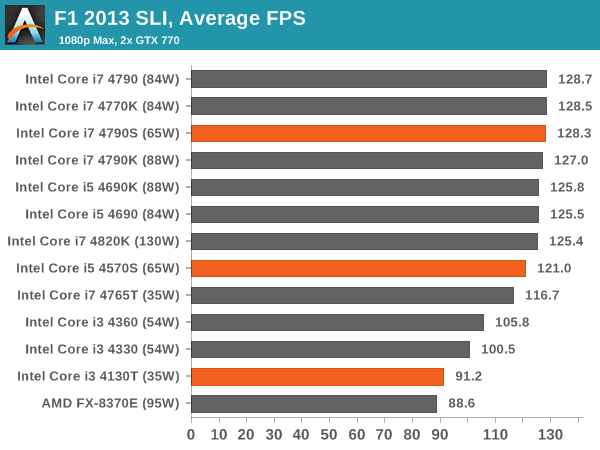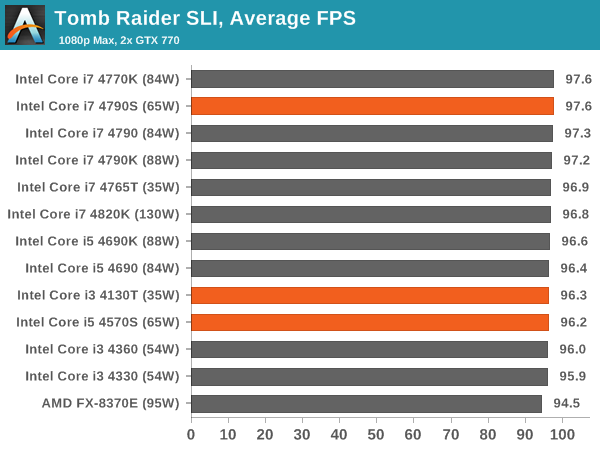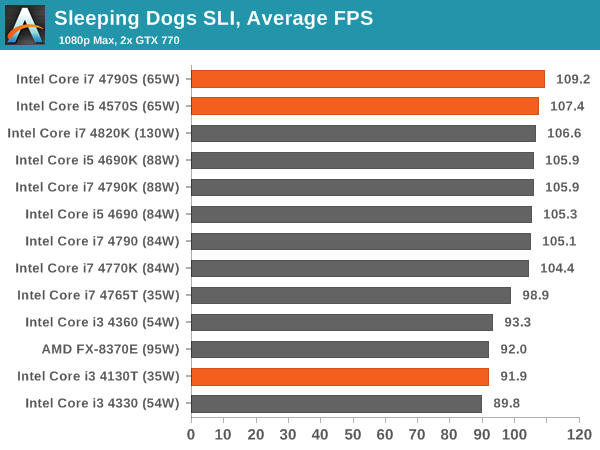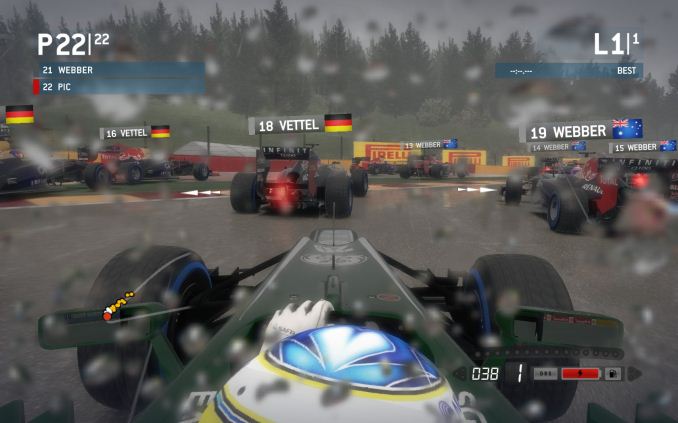Intel Haswell Low Power CPU Review: Core i3-4130T, i5-4570S and i7-4790S Tested
by Ian Cutress on December 11, 2014 10:00 AM ESTGaming Benchmarks on GTX 770
F1 2013
First up is F1 2013 by Codemasters. I am a big Formula 1 fan in my spare time, and nothing makes me happier than carving up the field in a Caterham, waving to the Red Bulls as I drive by (because I play on easy and take shortcuts). F1 2013 uses the EGO Engine, and like other Codemasters games ends up being very playable on old hardware quite easily. In order to beef up the benchmark a bit, we devised the following scenario for the benchmark mode: one lap of Spa-Francorchamps in the heavy wet, the benchmark follows Jenson Button in the McLaren who starts on the grid in 22nd place, with the field made up of 11 Williams cars, 5 Marussia and 5 Caterham in that order. This puts emphasis on the CPU to handle the AI in the wet, and allows for a good amount of overtaking during the automated benchmark. We test at 1920x1080 on Ultra graphical settings.

Bioshock Infinite
Bioshock Infinite was Zero Punctuation’s Game of the Year for 2013, uses the Unreal Engine 3, and is designed to scale with both cores and graphical prowess. We test the benchmark using the Adrenaline benchmark tool and the Xtreme (1920x1080, Maximum) performance setting, noting down the average frame rates and the minimum frame rates.

Tomb Raider
The next benchmark in our test is Tomb Raider. Tomb Raider is an AMD optimized game, lauded for its use of TressFX creating dynamic hair to increase the immersion in game. Tomb Raider uses a modified version of the Crystal Engine, and enjoys raw horsepower. We test the benchmark using the Adrenaline benchmark tool and the Xtreme (1920x1080, Maximum) performance setting, noting down the average frame rates and the minimum frame rates.

Sleeping Dogs
Sleeping Dogs is a benchmarking wet dream – a highly complex benchmark that can bring the toughest setup and high resolutions down into single figures. Having an extreme SSAO setting can do that, but at the right settings Sleeping Dogs is highly playable and enjoyable. We run the basic benchmark program laid out in the Adrenaline benchmark tool, and the Xtreme (1920x1080, Maximum) performance setting, noting down the average frame rates and the minimum frame rates.

Battlefield 4
The EA/DICE series that has taken countless hours of my life away is back for another iteration, using the Frostbite 3 engine. AMD is also piling its resources into BF4 with the new Mantle API for developers, designed to cut the time required for the CPU to dispatch commands to the graphical sub-system. For our test we use the in-game benchmarking tools and record the frame time for the first ~70 seconds of the Tashgar single player mission, which is an on-rails generation of and rendering of objects and textures. We test at 1920x1080 at Ultra settings.
















76 Comments
View All Comments
nathanddrews - Thursday, December 11, 2014 - link
Hmph.Khenglish - Thursday, December 11, 2014 - link
So you think these CPUs really are better binned? An undervolted K series cannot always pull off the voltages at the same clocks as a S series?If so do you think these better binned chips finally at least match Ivy Bridge in terms of performance per watt?
casteve - Thursday, December 11, 2014 - link
No, they aren't better binned. Another site looked at the voltage vs. freq curve and found that the std TDP, S, and T parts all followed the same curve. That i7 S part looks like an oddball.Samus - Thursday, December 11, 2014 - link
I work with HP Elitedesk 800's all the time with I5-4570S CPU's. They're incredibly small and quiet, much more so than the identically sized USFF dc7900 Core 2 Duo's they replaced.name99 - Thursday, December 11, 2014 - link
We constantly hear about how aggressively Intel bins parts, how each model is a special snowflake that's exactly optimized for its role, etc etc. I've yet to see any evidence that this is actually true (as opposed to "Intel engages in very aggressive market segmentation --- by product name".The primary reason I'm not convinced is that no-one else bins nearly as aggressively. Apple, never a company to miss the opportunity for a dollar, doesn't engage in some obvious binning (eg ship the iPhone6+ at 100MHz faster; or even give you a 100MHz speed boost in each model as you go from 16GB to 32GB to 64GB storage). Qualcomm offers a fairly limited palette of Snapdragon speeds. Samsung, the master if there ever was one, at slicing and dicing phone models, doesn't offer the same phone at speeds of 1, 1.5, and 2GHz; etc etc.
We have to assume that
- everyone else's processes are crazy uniform compared to Intel OR
- Intel is MUCH smarter than anyone in how they are able to bin OR
- binning (at the micro segmentation Intel offers) just is not a real thing
and the third option seems the most plausible to me.
Samus - Thursday, December 11, 2014 - link
Almost nobody pays attention to GHz numbers in mobile devices. Nobody really cares. And the scaling with ARM really means nothing. Apple consistently has among the highest performance ARM CPU's yet they're lower clocked and lower core count than everyone else. Binning ARM CPU's would require two things in order to be profitable: real-world benefits to a slightly higher clock speed, and marketing the higher clock speed as worth the premium. Currently there are neither. I'd guess 99/100 people don't even know the clock speed of the phone they own, because that's how irrelevant it is. For many applications (such as gaming, where performance is not consistent across the majority of devices) the GPU matters more than the CPU because of how heavily optimized these apps are for the GPU.The PC landscape is totally different.. You still have PC's sold that have 1/10th the performance of a Core i7.
Now, where your idea could be interesting is if they sell an "eco" chip that runs at a lower voltage due to binning. People MIGHT be willing to pay extra for a phone with +20% battery life.
Kjella - Friday, December 12, 2014 - link
Or perhaps the simplest and most obvious explanation - Apple feels they're more in the console game than the PC game. Offer one consistent level of performance across all iPhones of the same generation and that's the spec all developers need to relate to.Hrel - Friday, December 12, 2014 - link
- everyone else's processes are crazy uniform compared to Intel OR- Intel is MUCH smarter than anyone in how they are able to bin OR
Those are both true.
wumpus - Friday, December 12, 2014 - link
So Intel chips can't be overclocked and produce more watts than different lettered processors under identical conditions? That isn't what was tested and would be a rather shocking development.Chips take a considerable time to fab. Markets change fast and somehow Intel manages to produce what the market needs in the face on negligible competition? Yea, I really believe that they are really binning and not simply segementing to what marketing wants.
BSMonitor - Friday, December 12, 2014 - link
Use case. A PC's use case is an entirely different world than mobile phones. Your anti-Apple bias aside, what applications would users engage in on their smart phone where CPU performance could be noticeably segregated by clock speed. In this space. The only indication of CPU performance is the "snapiness" of the response from whatever app you are in.In a PC sense, I could launch an application or task that takes minutes, hours, etc.. 200-300 MHz would be noticeable over the course of an hour of video compression.
Apples and oranges.